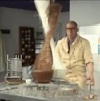
Cadbury’s “Chocolate Charmer” online advertising campaign provided ROI almost 4 times higher than their TV campaign. The chocolate brand ran a cross-media campaign for its Dairy Milk brand, covering TV, online ads and YouTube promoted videos. Despite only investing 7% of its budget in online, the brand saw the sector generate 20% of the sales. This case study from Gfk NOP highlights to growing power of online advertising in the marketing mix.
More on this case study:
Brand: Cadbury’s | Media: YouTube, TV, Social Media | Agency: Fallon London | Country: UK | Sector: FMCG
Market research agency GfK NOP has released the results of a study that evaluated the cross media performance of Cadbury’s recent Dairy Milk campaign. The study demonstrated the power of online advertising and its ability to deliver impressive returns on investment.
Cadbury’s Dairy Milk campaign was evaluated using the MEP (Media Efficiency Panel), a joint venture in the UK between GfK NOP and Kantar WorldPanel.
The campaign, which was planned and bought by PHD, utilised both TV and online platforms to execute a highly efficient campaign. The online portion of the campaign delivered more than £2 of short-term sales for every £1 spent. The real success story for Cadbury was their use of YouTube Promoted Videos which delivered three times the return on investment.
The online part of the campaign worked hard driving 20% of the sales associated to advertising, whilst only accounting for 7% of the budget.
Babita Earle, Divisional Director at GfK NOP, said: “We are extremely pleased with the results from this study. We believe there are some key learnings on how digital platforms can be used alongside traditional media to really optimise the efficiency of campaigns. It has helped answer questions critical to advertisers to today: How effective has the campaign been in driving sales and how the various platforms worked together?
Online delivered 19% additional reach
The campaign was planned so that TV and online could complement each other well in terms of formats used and the way it was targeted. The TV campaign coverage was balanced, leaving room for the online placements to make an impact. So whilst TV reached the masses, online worked to target new and exclusive audiences, delivering 19% additional reach. In addition, nearly two out of three consumers who saw Cadbury’s adverts online did not see them on TV.
The online campaign was most impactful amongst the younger audience
The campaign was even more effective amongst Cadbury’s target group of younger consumers. A higher proportion of this audience were reached online (48%) than through TV (46%) and once exposed, the impact the online adverts had in driving sales was greater than TV. In fact online was responsible for delivering two thirds of the sales associated to advertising amongst this base. So for Cadbury, online worked hard in reaching their target audience cost efficiently and with high impact.
Promoting engaging TV creative on YouTube can drive sales
The success of the online part of the campaign was also very much driven by the use of YouTube Promoted Video. YouTube Promoted Video alone delivered an impressive 14.5% additional reach to TV and exposures were measured to be particularly impactful in driving sales. This demonstrates that well planned online campaigns with engaging creative can complement TV.
Watch the video campaign here:
Digital Marketing Case Study | Cadbury’s YouTube Campaign
